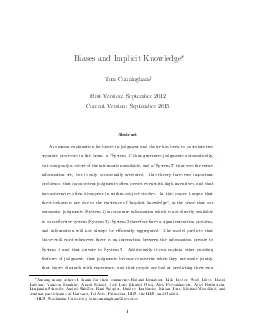

xz2EvxzbetweensituationsThesetwogeneralizationsthatinconsistenciesareinsensitivetoincentivesbutsensitivetojointpresentationsuggestthatourreectivejudgmentsobeyprinciplesofconsistencybutaredistortedby ID: 883829
Download Pdf The PPT/PDF document "Figure1Asimplerepresentationofatwosystem..." is the property of its rightful owner. Permission is granted to download and print the materials on this web site for personal, non-commercial use only, and to display it on your personal computer provided you do not modify the materials and that you retain all copyright notices contained in the materials. By downloading content from our website, you accept the terms of this agreement.
1 x,z##"""""""""""""""""""""!"#$%&'(2E[v|x
x,z##"""""""""""""""""""""!"#$%&'(2E[v|x,z Figure1:Asimplerepresentationofatwo-systemsmodel:System1isabove,System2isbelow.Bothsystemsformrationalexpectationsabouttheunobservedvariablev,howeverSystem1receivesonlyx(low-levelinformation),whileSystem2additionallyreceivesz(high-levelinformation).Althoughthisclassofmodelshasbeenusedtogivepersuasiveanalysesofindividualbi-ases,theysu!erfromtwoimportantempirica
2 lproblems:theresponseofbiasestoincentive
lproblems:theresponseofbiasestoincentives,andtheresponseofbiasestojointevaluation.First,themodelpredictsthatbiaseswilldisappearwhenSystem2isactivated,whichshouldoccurwhenevertimeandincentivesaresu"cientlyhigh.Althoughincentivesdotendtoreducethemagnitudeofbiases,itiscommonlyobservedthatmanybiasesremainevenwhenthestakesbecomequitehigh.CamererandHogarth(1999)sayÒnoreplicatedstudyhasmaderationalityviolatio
3 nsdisappearpurelybyraisingincentives.ÓSi
nsdisappearpurelybyraisingincentives.ÓSimilarly,behavioroutsidethelaboratoryoftenseemstobeinßuencedbyirrelevantinformationevenwithveryhighstakes(Postetal.(2008),ThalerandBenartzi(2004)).Asimilarpointistrueforperceptualillusions:spendingalongertimestaringattheillusionmayreducethemagnitudeofthebias,butitrarelyeliminatesit(Predebonetal.(1998)).Thusitbecomesapuzzle2Althoughthetheorieslistedallsharethesameb
4 asicdiagnosisofwhybiasesoccur,theydi!ero
asicdiagnosisofwhybiasesoccur,theydi!eronanumberofotherimportantdimensions,discussedlaterinthepaper.MorerecentlytheSystem1/System2terminologyhasbeenusedtorefertodi betweensituations.Thesetwogeneralizations-thatinconsistenciesareinsensitivetoincentives,butsensitivetojointpresentation-suggestthatourreßectivejudgmentsobeyprinciplesofconsistency,butaredistortedbythesamebiasesthatdistortourautomaticsystem.T
5 hiscouldoccurifSystem2Õsjudgmenttakesint
hiscouldoccurifSystem2ÕsjudgmenttakesintoaccountthejudgmentsthatSystem1makes.Andthis,inturn,wouldberationalifSystem1ÕsjudgmentsincorporatedinformationnotaccessibletoSystem2.Thispaperproposesthatthereasonwemakeinconsistentjudgmentswhenusingourfullreßectivejudgmentisthatindi!erentsituationswereceivedi!erentsignalsfromSystem1(orintuitions),anditisrationaltotakeintoaccountthosesignalsbecausetheycontainvalu
6 ableinformation.Icalltheunderlyingassump
ableinformation.Icalltheunderlyingassumptionimplicitknowledge,becauseitisknowledgethatisprivatetoourautomaticsystem,andthusavailabletoourreßectivesystemonlyindirectly,throughobservingtheautomaticsystemÕsjudgments.Figure2showshowtheformalanalysisdi!ers:System1nowhasaccesstoprivateinformation,!,andSystem2canobserveSystem1Õsposteriorjudgment(E[v|x,!]).System2facesasignalextractionproblemininferring!from |
7 x,!]! !!!!!!!!!!!!!!!!!!!!!x,z##""""" |x
x,!]! !!!!!!!!!!!!!!!!!!!!!x,z##""""" |x,z,E[v|x,!]]!!Figure2:Atwo-systemmodelwithimplicitknowledge:System1nowadditionallyreceivesprivateinformation,!,andSystem2conditionsitsjudgmentsonSystem1Õsexpectation.notbeabletoperfectlyextractthisinformation,andSystem2Õsjudgmentwillnotbethesameasifithadaccessto!.WecanthereforedeÞnetheÒbiasÓofthetwosystemsrelativetothebenchmarkcaseinwhichalltheinformationispooled
8 :4System1Õsbias=E[v|x,!]" x,z,!](2) repr
:4System1Õsbias=E[v|x,!]" x,z,!](2) reproducingthem.Asasimpleexample,mostpeopleÞnditdi"culttoanswerthequestionÒisthereanEnglishwordwhichcontainsÞveconsecutivevowels?Ó,butinstantlyrecognizethatthestatementistruewhentheyareremindedofawordthatÞtsthepattern.7Mostpeoplecaneasilyrecognizewhetherasentenceisgrammatical,buthavedi"cultymakinggeneralizationsaboutthesetofgrammaticalsentences.8Thesedistinctionsinac
9 cessibilitywouldnotexistifourknowledgewa
cessibilitywouldnotexistifourknowledgewasexplicit,i.e.storedasadistributionoverpossiblestatesoftheworld.Thispaperproposesthattheknowledgeweuseinmakingeconomicdecisionsisstoredinasimilarlyimplicitform:thatpeopleareabletomakeconÞdentsnapjudgmentsaboutthevalueofdi!erentalternatives,buttheyhavelimitedinsightintohowthosejudgmentsareformed.Thisseparationofknowledgebetweensystemscanexplainwhyourdecisionsoften
10 violatenormativeprinciplesthatwereßectiv
violatenormativeprinciplesthatwereßectivelyendorse.Themodelmakesavarietyofpredictionsabouthumanjudgment:(1)biaseswilloccurwhenthereisaninteractionbetweenimplicitknowledgeandhigh-levelinformationininfer-ringv(i.e.,between!andz);(2)judgmentswillappearinconsistenttoanoutsideobserverbecauseindi!erentsituationsthereßectivesystemwillhavedi! |Fv(")=v,Fx(")=x,Fz(")=z,F!(")=!}),andconditionaldistributionsderive
11 dfromthat.WecanthendeÞnethefollowingexpe
dfromthat.WecanthendeÞnethefollowingexpectations,whichrepresentrespectivelytheexpecta-tionsaboutvformedbySystem1,bySystem2,andbyahypotheticalagentwhoisabletopoolbothinformationsets:E1=E[v|x,!]E2=E[v|x,z,E[v|x,!]]E System2Õsbias=E2"EPBothE1andE2willhaveazeroaveragebias,i.e.E[E1"EP]=E[E2"EP]=0,however i.e.thebiaswhichsurvivesinapersonÕsreßectivejudgment.WhenIsaythatjudgmentisunbiasedIwillmeanthatforallx#
12 X,!#A,z#Z,E[v|x,z,E[v|x,!]]=E[v|x,z,!]2.
X,!#A,z#Z,E[v|x,z,E[v|x,!]]=E[v|x,z,!]2.1ConditionsforaBiasinReßectiveJudgmentAsimplesu"cientconditionforunbiasednessisthatE[v|x,!]isaone-to-onefunctionof!.IfitwasthenSystem2wouldsimplybeabletoinvertE1toinfer!.Howeverthisconditionisnotnecessary,becauseinmanycasesSystem2canextractalltheinformationitneedsfromE1withoutknowing!.Weareabletogivemoreinterestingconditionsbelow.TherelationshipbetweenE1,E2,andEP
13 canbeillustratedinthefollowingtable:9Amo
canbeillustratedinthefollowingtable:9Amoresophisticatedmodelwouldallowthisdecisiontocond E[v|!]E[v|x,z,!!]E[v E1)mustalsobeidenticalforeverycell.Proposition2.Judgmentwillbeunbiasedifandonlyif,forallx#X,!,!!#A,E[v|x,!]=E[v|x,!!]=)*z#Z,E[v|x,z,!]=E[v|x,z,!!]ToillustrateIgiveanexamplewhereaggregationofinformationfails(xisignoredinthisexample).Example1.Letv,!,z#{0,1},withf(v=1)=12.Supposethatifv=0then!andz
14 areuniformlydistributedandindependent,bu
areuniformlydistributedandindependent,butifv=1thenwithequalprobability!=z=1,or!=z=0.I.e.,forall!,z#{0,1}:f(!,z|v=0)=14f(!,z|v=1)=#$$%$$&12 [v|!,z]=#$$%$$&23,!=z0, v|E[v|!],z]=12Herethepooled-informationexpectationincludesaninteractiontermbetween!andz.Inthiscasewedonotknowwhetherarealizationof!representsgoodnewsorbadnewsabout !,sobothSystem1and2willbebiasedrelativetothepooled-informationbenchmark(i.e.,*
15 !# v|x,z,!]isweaklymonotonicin!whenorder
!# v|x,z,!]isweaklymonotonicin!whenorderedby,x.Intermsofthetableabove, ,andi:R$R,suchthatEP=E[v|x,z,!]=i(g(x,!)+h(x,z))andiisstrictlymonotonic.Proof.Inthiscaseforanyxthereexistsanorderingof foranyz(i.e.,theorderingaccordingtog(x,!)).Judgmentwillthereforebeunbiased,bythepreviousproposition.Theexistenceofbiasissensitivetothedistributionofknowledge:forexample,nobiaswouldoccurifyoursisterkneweverythingabou
16 tthehalfofthebaseballcardsthatarealphabe
tthehalfofthebaseballcardsthatarealphabeticallyÞrst,A-M,andyoukneweverythingaboutthe x,!),notjustE[v|x,!]).TheyalsoshowthatE1willalmostalwaysrevealtheentireposterior,in elements,v=Rm,x=Xm,!=Am,z=Zm,withthejointdistribution, )asasituation,andanelement(xi,zi E[v|x,!]E2=E[v|x,z,E1]EP=E[v|x,z,!]Aswritten,thissetupallowsmanychannelsofinference,soIintroducefurtherassumptionsinordertoconcentratejustonthechann
17 elsofinterest.First,asdiscussed,ourprinc
elsofinterest.First,asdiscussed,ourprincipalinterpretationisthatSystem1Õsprivateinformationrepresentslong-runknowledge,soIassumethatallelementsof!areidentical,andthereforesimplyrefertoitas!.Second,Iwillassumethateachcase(xi,zi wereinformativeabout!thenwewouldexpectjointandseparatejudgmenttodi!erevenwithoutanysignalfromSystem1.Finally,wewillalsoassumethatallobservableinformationabouteachobjectisidiosyn-
18 cratic,i.e.xiandziareinformativeonlyabou
cratic,i.e.xiandziareinformativeonlyaboutvi,notaboutvjforj(=i.Thesethreepointsareincorporatedintothefollowingassumptionaboutthedistributionofinformation:fm(v,x,z,!)=(m)i=1f(vi|xi,zi,!)*f(z|x)f(x)f(!)(A1)WecanÞrstnotethat,withinthisframework,neitherSystem1Õsexpectationnorthepooled-informationexpectationwilldi!erbetweenjointandseparateevaluation,i.e.:Ei1=E[v|xi,!]EiP=E[v|xi,zi,!]HoweverwhenSystem2observe
19 savectorE1,itcanlearnabout!fromtheentire
savectorE1,itcanlearnabout!fromtheentiresetof11Forexamplewithbaseballcards,youmightinferthatmorecommoncardsarelessvaluable,andthiscouldcauseseparateandjointevaluationtodi!erforanoth x#Xm,z#Zm,x!#Xn,z!#Zn,withxi=x!iandzi=z!ifori#{1,...,m},thenforanyj#{1,...,m}Var[Ej2"EjP]'Var[E!j2"E!jP]whereE2=E[v|x,z,E[v|x thedecision-makercanremembertheirintuitionsforprevi ,z!)isevaluatedwithoutanyhistory.Inotherwords
20 ,moreexperienceispredictedtoreducethebia
,moreexperienceispredictedtoreducethebias.Toapplythispredictionaboutsequentialjudgmentsrequiresinterpretationofwhenasetofcasesarepartofthesamesituation.TheimportantassumptionisthatSystem2canrecallallpreviousstimuli( .InsomecasesIwillinterpretthisasautilityfunction,inwhichtheunknownutilityofanobjectisinferredfromitsfeatures.12One x,z)=u(x!,z!)}.Wewillbeinterestedonlyinconvexrestrictions,i.e.:DeÞnition1.
21 |x,z,E[v|x,!]]. theresultwillbemixed:wh
|x,z,E[v|x,!]]. theresultwillbemixed:whenevaluationsaremadeseparately(i.e.,whenconditioningondi!erentsetsx),thentherestrictionmaybeviolated,butwhenevaluationsaremadejointly,withthesameconditioningsetx,theywillalwayssatisfytherestriction.13Forexample,theindi!erencerestriction{u:u(x,z)=u(x",z")}isconvexbecauseanymixturebetween thenforall!#A,x#Xm,�m1,u!,x2(x,z)#UForexampleconsiderhowpeoplewillresp
22 ondtoirrelevantdi!erences.Supposethatour
ondtoirrelevantdi!erences.Supposethatourrestrictionis,asabove,thatforsomex,x!#X,z,z!#Z,{u:u(x,z x,z 1,c!2,c!,x2pickoutthemaximalelementsofthechoicesetaccordingtothefunctionsu!P,u!1,u!2,andu!,x2).Inthecaseofc!,x2Imakethefurtherassumptionthattheconditioningsetxisformedbyelementsofthechoiceset,D "Z,andcorrespondingchoicerestrictionCU-DD,15ifpooled-informationjudgmentsatisÞesU(*!#A,u! )=argmax(x,z)#Au(x,z
23 Proof.Bytheproposition,eachu!,x2belongst
Proof.Bytheproposition,eachu!,x2belongstoU,thereforeitmustsatisfythechoicere-strictionsimpliedbyU.DecisionsmadebySystem1mayviolaterestrictionsaxiomsonchoice,becausethosedecisionswillfailtoconditiononz(putanotherway,inattentivedecisionsmayviolateaxiomsofchoice).Proposition5impliesthatSystem2Õsdecisionswillneverviolateanaxiominagivenchoiceset,althoughdecisionsmadeseparat !!,z) ,!!#A,.x#X,E[v|x,x,v|x,!!]L
24 earnabilityisanaturalrestrictionifwethin
earnabilityisanaturalrestrictionifwethinkofSystem1asanaivelearner:i.e.,if Z,x#X,m#N,x#Xmx!#x0)x!# fislearnable,thereisonlyasingle!#Athatisconsistentwiththispattern,thusE[!|x,E1]=!.ThereforeE2=E[v|x,z,E1]=E[v|x,z,!]=EP. =R2),andE[v|x,z,!1,!2]isassumedtobeincreasinginboth!1and!2.System1observes(!1,!2)andcalculatesanexpectation,E1=E[v|x,!1,!2].System2observesthatexpectation,andthereforelearnsthat!1and!2li
25 eonacertaincurve,whichleadshimtoupdatehi
eonacertaincurve,whichleadshimtoupdatehisposteriorover(!1,!2).Anaturalassumptionwillbethat,whenSystem2observesahigherE1,hisposteriorsoverboth!1and!2increase,inthesenseofhavinghigherexpectedvalues.IfthisistruethentherewillbeaÒspilloverÓe!ect:anincreasein!1willcauseanincreaseinSystem2Õsestimateof!2.Thusinsituationswhere!1isknowntobeirrelevant,itwillneverthelessa!ectSystem2Õsjudgment,andthedirectionofinßu
26 encewillbepredictable. isirrelevant(i.e.
encewillbepredictable. isirrelevant(i.e.,undersomerealizationofxandz,!1isunrelatedtov),neverthelessSystem2Õsjudgmentwillbeamonotonicfunctionof!1.Forexample,whenyouknowthattheBabeRuthcardiscounterfeit,yourbidwillbeneverthelessincreasinginthevalueofthatcard,becauseitsvalueindirectlya!ectsyourjudgmentthroughyoursisterÕsreportofthevalueofthepacket.Asimpleexampleisif IdeÞnethispropertyasunambiguousness,mean
27 ingthatachangein!whichincreasesE1willwea
ingthatachangein!whichincreasesE1willweaklyincreaseE2,forallvaluesofxandz:DeÞnition3. v,nomattertherealizationofz.If! andzareindependent,andE1=E[v|x,!]=n'i=1 |x,z,!]=E[v ?Icallthispropertycongruence:DeÞnition4.Adistributionfiscongruentforsomex,x!#X,andz#Zif, fisunambiguousinthesensedeÞnedabove.TherearetwoqualiÞcations.First,ifSystem2knowsthatx!isassociatedwithahighervthanx,thenitwillalreadydiscountthee
28 !ectonE1.Thereforewearereallyinterestedi
!ectonE1.Thereforewearereallyinterestedinthedi!erencebetweenwhateachSystembelievesabouttherelationshipbetweenxandv.AnaturalbenchmarkiswhenSystem2expectsnodi!erence:i.e.,whenE[v x!!,z,!1,!!2]forallx!!#X,!1#A1,!2,!!2#A2(iv)given! inducesahigherjudgmentthanx,evenwhenpeopleknowthatthedi!erenceisnorma-tivelyirrelevant,then,undertheassumptionsabove,thisimpliesthatE[v|x!,!]�E[v|x,!],i.e.thatonaverage(i
29 gnoringz)x!isassociatedwithhigherv,thoug
gnoringz)x!isassociatedwithhigherv,thoughpeoplemaynotbeconsciouslyawareofthisassociation.Idiscussevidenceforthispredictioninalatersection.3GaussianModelInthissectionIassumeaspeciÞcdistributionforf(v,x,z,!),andsolveexplicitlyforthebias.UnderthisdistributionSystem2Õsproblemcanbeseenasreweightingaweightedaverage.System1Õsestimate,E1,willbeaweightedaverageoftheirprivateinformation(!1,...,!n),withweightsgiv
30 enbythepublicinformation( =E[v|!,z]=n'j=
enbythepublicinformation( =E[v|!,z]=n'j=1!jzjWecanthereforeexpresseachSystemÕsexpectationas:E1=n'j=1! ]=E[!j]+E[ [zj]2$2j:E2=n'j=1E[!j|E1]zj=n'j=1E[!j]zj+n'j=1%j+ !jshouldbegivenlessweightthanusual),thenSystem1willtendtoover-reacttofeaturej,andviceversa.WecanwriteSystem2ÕsÞnalbiasas:E2"EP=n'j=1E[!j]zj+n'j=1%j+k%kE1"E0E[zj]zj"n'j=1!jzj=n'j=1(E[!j]"!j)zj+(E1"E0)+n'j=1zj"E[zj]E[zj]%j+k%k(E1"E0)=n'j=1(E[!j
31 ]"!j)zj+n'j=1(!j"E[!j])E[zj]+n'j=1zj"E[z
]"!j)zj+n'j=1(!j"E[!j])E[zj]+n'j=1zj"E[zj]E[zj]%j+k%k(E1"E0)=n'j=1(E[zj]"zj)((!j"E[!j])"1E[zj]%j+k%k(n'k=1(!k"E[!k])E[ P=n' j+ !j])"%j+k%k'k$=jE[zk]E[zj](!k"E[!k])*TheintuitioncanbebetterunderstoodwithafurthersimpliÞedversion,conditioningjustonsomepair!j,zj, rminedbythedeviationsof!andzfromtheirexpectedvalues.Wecanmakeanumberofobservationsaboutthenatureofthebiases:1.Abiasrequiresthatboth !j],thiswillca
32 usepeopletooverestimatev.Intuitively,the
usepeopletooverestimatev.Intuitively,thesecondSystemdiscountsthesignal,because!jislessimportantthanusual.But!jisbiggerthanexpected,sothereßectivesystemdoesnotdiscountenough.3.ThesizeofSystem2Õsbiasisdecreasingin%j=$2jE[zj]2.Ahigher willbeattributedto!j,andthereforethebiaswillbesmallerbecausethediscountappliedtoE1willbegreater.Inotherwords,ifSystem2islesssureaboutthee!ectof!j,thenitwillbelessinßuencedby
33 changesin!j.Thismodelhasasimpleinterpret
changesin!j.Thismodelhasasimpleinterpretationasthereweightingofaweightedaverage.ForexampletheUSEPAÕsÒcombinedMPGÓfornewcarsiscalculatedasaweightedaverageofcityMPG(55%)andhighwayMPG(45%).Eachcarbuyermayhavetheirownpreferredweights.IfIobserveonlytheEPAÕscombinedMPGforacar,Iwillthenhavetoinfertheunderlyingdatainordertoconstructmypreferredweighting.IfmypriorsaboutthecarÕsunderlyingMPGvariablesareGaussian,t
34 henthemodelinthissectionisanexactdescrip
henthemodelinthissectionisanexactdescriptionoftheproblemIface,withSystem1representingtheEPAandSystem2representingme.MyposteriorcanbedescribedbytheexpressionaboveforE2,andmybiasrelativetothecaseinwhichIknewtheunderlyingdataasE2"EP(heren=2,!willrepresentthecityandhighwayMPGvariables,zaremyidiosyncraticweightings,andtheEPAÕsweightscouldbeinterpretedasE[z],i.e.theaverageweightsusedbycarbuyers).Thepredictio
35 nswillapplytobuyingacar:ifmyweightsdi!er
nswillapplytobuyingacar:ifmyweightsdi!erfromtheEPAÕsweights,andifthecarÕsattributesdi!erfromtheirexpectedvalues,thenmyjudgmentwillbebiasedinapredictableway.Insomecasesmyjudgmentwillbea!ectedbyinformationIknowtobeirrelevant:ifIputa0%weightonhighwayMPG,neverthelessIwillvaluemorehighlyacarwhichhasahigherhighwayMPG,everythingelseequal(becausehighwayMPGa!ectstheEPAÕscombinedMPG,whichinturnaectsmybeliefsabou
36 tcityMPG).3.1JudgingAlternativeswithAttr
tcityMPG).3.1JudgingAlternativeswithAttributesInowextendtheGaussianmodeltoincludepublicinformationwhichcanbeinterpretedasasetofattributes(x#Rn)whichareobservabletobothSystem1andSystem2.Iassumethattheinterpretationoftheseattributesisa!ectedboth [v|x,z,!]=n'j=1xjzj!j(4)Asbefore,inordertoachieveananalyticalsolution,Iassumethateachelementin!isdrawnfromanormaldistribution,i.e.!j1N(E[!j],$2j forE[zj].Thesolu
37 tionsaretherefore:E1=E[v|!,x]=n'j=1 1]=E
tionsaretherefore:E1=E[v|!,x]=n'j=1 1]=E[!j]+E[zj]2x2j$2!j+kE[zk]2x2k$2!kE1"E0x P='j(E[zj !j]),1"&j+k&k-+&j+k&k1E[zj]xjn'k$=j(!k"E[!k])E[zk]xk*where&j=$2jE[zj]2x2j.Asbefore,asimplerwaytounderstandthisresultistoderivetheaveragebiasforsomegiven!j,zj.E[E2"EP|x,zj,!j]="(zj"E[zj])(!j"E[!j])xj,1"&j+k& "&j+k&k-=xj,1"$2jE[zj]2x2j+k$2kE[zk]2x2k-=xj+k$2kE[zk zj]).19Intuitively,thisnon-monotonicitycanbethoughtofl
38 ikethechangeinestimatedsignalduetoachang
ikethechangeinestimatedsignalduetoachangeinthesignal-to-noiseratio.Whentheratioisverylow,youremainatyourprior.Whenitishigh,youlearnthesignalquiteprecisely.Whenitisintermediate,yourestimateofthesignalwillbetendtobebiasedtowardstherealizationofthenoise.Appliedtoperceptionandjudgment,thise!ectcorresponds =E[v|x,!]E !jxijE[zj]Inmatrixnotationthiscanbewritten,E1=x(!3E[z])where(P3Q)ij=Pij+Qij.Forcompactness,
39 andwithoutlossofgenerality,IsetE[zj]=1fo
andwithoutlossofgenerality,IsetE[zj]=1forallj.AsbeforeSystem2wishestoinfer!fromE1,buthenowhasmoreinformation.Becausetheelementsof!aredistributedindependentlyandnormally,theexpectationof!,ö!,willmaximizethelikelihoodfunction,"(ö!"E[!])T"(ö!"E[!])subjecttotheaboveconstraint,where"isadiagonalmatrix,withelements$%21,...,$%2n,andPTisthetransposeofP.TheÞrst-orderconditionofaLagrangiancanbewritten(BoydandVand
enberghe(2004),p304):2(ö!"E[!])T"='xö!=E[!]+12"%1xT'T37 !]+12x"%1xT'T(x"%1xT)%1(E1"xE[!])=12'TThiscanbesubstitutedbackintotheÞrst-orderconditiontoget:ö!=E[!"%1xT(x"%1xT)%1(E1"xE[!])Proposition11.System2ÕsbiascanbeexpressedasE2 Ep=0).Likewise,ifevery!j=E[!j],thenE2=EP.Inthiscase,ifyouobserveasu"cientnumberofobjectsyoucaninferallofSystem1Õsinformation,andthereforebiaswillgotozero.Inparticulariftherearen
41 SimilarargumentsaremadebyMarr(1982)andFo
SimilarargumentsaremadebyMarr(1982)andFodor(1983).22SimilarlyhesaysÒtheconstraints[i.e.,inferencesmadebythevisualsystem]showupeveniftheobserverknowsthatthereareconditionsinacertainscenethatrendertheconstraintsinvalidinthatparticularcase Second,thatassociation-basedjudgmentspersist;hegivesexamplesofreasoningproblemswhichÒcausepeopletobelievebelievetwocontradictoryresponsessimultaneously...[inwhich]theÞr
42 stresponsecontinuestobecompellingirrespe
stresponsecontinuestobecompellingirrespectiveofbeliefinthesecondanswer,irrespectiveevenofcertaintyinthesecondanswer.ÓStanovichandWest(2000)introducedtheÒSystem1ÓandÒSystem2Óterminology,andadditionallyarguedthatSlomanÕsdual-systemmodelcouldgiveagoodaccountofinterper-sonaldi!erencesinsusceptibilitytobias.DanielKahnemanhassinceadoptedtheSystem1/2terminologyasafoundationfortheÒheuristicsandbiasesÓprogram(K
43 ahnemanandFrederick(2005),Kahneman(2011)
ahnemanandFrederick(2005),Kahneman(2011)).Eachofthesewritersusesdi!erentwordstodescribetheknowledgewhichtheautomaticdoesnothaveaccessto(inthelanguageofthispaper, importanttotheinterpretationofthecurrentsituation,butourautomatically-producedintuitionsmaynottakethemintoconsideration.Finallyturningtoeconomicsanumberofrecentmodelshaveproposedthatpeoplemakerationaldecisionsbutusingonlyasubsetoftheavailablei
44 nformation;thisliteratureisoftencalledÒi
nformation;thisliteratureisoftencalledÒinattentionÓorÒrationalinattentionÓ(Sims(2005),Chettyetal.(2007),Woodford(2012),CaplinandMartin(2011),Gabaix(2012)).Thesetheoriesputlessemphasisontheexistenceoftwoseparatesystems,andinsteadassumethattheamountofinformationcanvarycontinuously,thoughinpracticetheyoftenemphasizethatthechoiceofinformationmaybemadeonce,exante,foraseriesofsubsequentdecisions.27Thepartiti
45 onbetween ÓÕDiscussingaparticularexample
onbetween ÓÕDiscussingaparticularexampletheysayÒ[A]lthoughpeoplearecapableofconsciouslycorrectingtheirimpressions...theycommonlyfailtodoso.ÓThemodelinthispaperdi!er Thereisevidencethathavingshortconsiderationtime,orcognitiveload,doestendtoincreasebiases,andthishasoftenbeenregardedasevidenceinsupportofadual-systemmodelofjudgment(Pocheptsovaetal.(2009),Alos-FerrerandStrack(forthcoming)). improvemeandecis
46 ionperformance...incentivesreducebiasesi
ionperformance...incentivesreducebiasesinonlyahandfulofcases.ÓThereisalsoevidencefromoutsideofthelaboratorythatdecisionscanbeinßuencedbynormativelyirrelevantdetailsevenwhenthestakesareveryhigh(Postetal.(2008),ThalerandBenartzi(2004)).Asimilarpointistrueforperceptualillusions:spendingalongertimestaringatanillusionwillsometimesreduceitsmagnitude,butrarelyeliminatesit(Predebonetal.(1998)).5.2BiasesareRati
47 onalgiventheInformationUsedThemodelpredi
onalgiventheInformationUsedThemodelpredictsthatanomaliesinjudgmentreßectoptimalinferencegiventheinformationavailabletoeachsystem.Thishastwoaspects.Underlowincentives(whenonlySystem1operates)judgmentsshouldberationalrelativetothelow- )whichisnormativelyirrelevantinthecurrentcase,then(i)thischangeshouldordinarilybeapositivesignalaboutv,and(ii)peopleshouldnotbeconsciouslyawareofthisassociation(ortheyunder
48 estimateit).Thisis29SeealsoHarrison(2006
estimateit).Thisis29SeealsoHarrison(2006). model.Thispredictionisacommonobservationinthestudyofperception.Inmanycaseslaboratoryexperimentshaveestablishedarelationshipbetweensensationandperceptionthatseemsarbitrary,butislaterfoundtocorrespondtoafactaboutthephysicalworld,i.e.thesensationisdiscoveredtobecorrelatedwiththepropertybeinginferredbyperception.AfamousexampleisEHWeberÕsdiscovery,in1876,thatcoolco
49 insarejudgedtobeheavierthanwarmcoinswhen
insarejudgedtobeheavierthanwarmcoinswhenplacedontheforehead.Weberproposedthatinformationabouttemperatureandpressurearesentthroughthesamenerves,thuscausinginterferencebetweenthesignals.Howeveritwaslaterfoundthatseparatenervescarriedthesignals,andthecommonlyacceptedmodernexplanationofthisphenomenonisthattemperatureisinfactaninformativesignalaboutweight:aheavycoinwillpressmoredeeplyintoyourßesh,soitwillma
50 keyourskincolderthanalightcoin(ifthecoin
keyourskincolderthanalightcoin(ifthecoinisbelowskintemperature).Thuswhenreceivingacoolersensationitisrationaltoinferthattheobjectonyourforeheadisheavier,allelseequal.Supportforthisexplanationcomesfromevidencethatjudgmentofweightis Infact,TverskyandKahnemanÕs1974paperintroducingthephraseÒheuristicsandbi-asesÓgivesamotivatingexamplefromperceptionthatÞtsthemodelinthispaperverywell.Theydiscussevidencethatp
51 eoplesystematicallyover-estimatedistance
eoplesystematicallyover-estimatedistancesonfoggydays.Thestandardexplanationforthisbiasisthatpeoplerationallyuseblurrinessasacueforesti- ToconÞrmthispredictionIranasurvey,askinghowfoga!ectsperceptionofdistance. i]!irepresentthatSystem2underestimatesthisrelationship.Finallyforafoggydayletzi[z ,willbeproportionalto ratelymayviolaterulesofconsistency,butjudgmentselicitedjointlywillalwaysbeconsistent.Noteag
52 ainthatjointly-elicitedjudgmentsneednotb
ainthatjointly-elicitedjudgmentsneednotbeunbiased,justconsistentrelativetosomenormativeconstraint.Notealsothattestingthispredictiondoesnotrequireknowinghowinformationispartitionedbetweenlow-levelhigh-levelaspectsofthecase(xandz).EvidencefromawidevarietyofsourcesseemstoconÞrmtheprediction.33Thesimplestcaseisofframinge!ects,whereanirrelevantchangeinthecontexta! A,E[v|x,z,!]=E[v|x",z",!],butE[v|x,z,E[v|x,
53 !]](=E[v|x",z",E[v|x",!]].35Someframinge
!]](=E[v|x",z",E[v|x",!]].35Someframinge!ectscannotbeeasilybepresentedjointly:forexample,choiceisoftena!ectedbymanipulationsofreferencepoint(asinKahnemanandTversk obabilitywasdistributeduniformlybetween$0and$10.Thedistributionofprobabilitiesisnormativelyirrelevant,byourusualstandards,yetthesubjectsineachconditionstatedasigniÞcantlydi! Finally,thesubjectswerepresentedwithbothdistributionsandaskedtosubmi
54 ttwobids,oneforeachscenario,andtheactual
ttwobids,oneforeachscenario,andtheactualdistributionusedwassubsequentlychosenbycoinßip.Inthisversionthedi!erenceinbidsshrankdramatically:theaveragebidswere$3.09and$3.38,respectively.ThisexperimenthasaclearinterpretationintermsofthispaperÕsmodel:thedistributionsofpricesaresalientfeatures(xandx!),butineachcasehigh-levelinfor-mation(zandz!)tellsusthatthedistributionisnormativelyirrelevant(i.e.,theserepres
55 entinformationthatthedistributionsareran
entinformationthatthedistributionsarerandomlydrawn).Judgmentisneverthelessa! 37 andone-thirdofsubjectsÕswitchÕpreferencesonrepeatedquestions.ÓHoweverastrikingfactisthat,despitethisvolatility,subjectsveryrarelychooseastochasticallydominatedoption(CarboneandHey(1995),LoomesandSugden(1998),Hey(2001)).38Thisisaparadoxformodelsofattention:peopleareinattentiveenoughtomakeinconsistentchoices,butattentiveenoug
56 htoneverchooseadominatedalternative.Howe
htoneverchooseadominatedalternative.Howeverthispatternmatchesamodel,asinthispaper,inwhichsubjectshavenormativepreferences,butreceiveadi!erentsignalaboutthenatureofthosepreferencesineachsituation.39KahnemanandFrederick(2005)discussthedi!erencesbetweenseparateandjointjudg-ment.40TheynotethatmanyjudgmentanomalieswereÞrstdiscovered therepeatedpairswas12percent.Ó39Thefactthatpeopleoftenreversetheirpreferenc
57 escouldbeduetoanyoftheothernoisepickedup
escouldbeduetoanyoftheothernoisepickedupbySystem1:thehistoryofpriorcases,orthetimeofday,orafeelingoffatigue. ,wherep!dominatesp.Thesechoicesareallowedbythemodelinthispaper,butitpredictsthatthepumpwillrunoutifthedecisionsaremadesequentially,i.e.afterbeingexposedtoallthreealternatives(p,p!,q)subjectswillmakesubsequentdecisionswiththesamebeliefsabout!,sowillmakeconsistentdecisions.Thispredictionissupporte
58 dbyChuandChu(1990),whoÞndthatclassicalpr
dbyChuandChu(1990),whoÞndthatclassicalpreferencereversals(LichtensteinandSlovic(1971))decreasesigniÞcantlyafterchoicesaremadesequentially,suchthatsubjectscometofacethepossibilityofamoneypump.Finally,whenappliedtoperceptualbiases,thetheorymakesthecounterfactualpredictionthatinconsistencieswilldisappearinjointpresentations.Thisproblemcanberesolvedifweadditionallyassumethatpeopledonothavedirectreßectiveac
59 cesstotheirownrawsensations,acommonobser
cesstotheirownrawsensations,acommonobservationintheliteratureonperception.Takethecommonillusion tionwillnotholdifSystem1observesadditionalcase-speciÞcinformationwhichisnotaccessibletoSystem2:thenSystem2willnotknowthatthedi!erencebetweenthetworeports(E1andE!1)isdueonlytothebackgroundcolor.Thisassumptionseemsreasonable:thatpeopledonothave43Similarcontraste!ect Finally,Loewensteinetal.(2003)discussfurther
60 evidencethatpeoplearepoorjudgesoftheirfu
evidencethatpeoplearepoorjudgesoftheirfuturepreferences(ÒprojectionbiasÓ).6Discussion6.1RelatedLiteratureThemodelinthispaperissimilartoexistingdual-agentmodelswithineconomics(e.g.,Fu-denbergandLevine(2006),BrocasandCarrillo(2008))inthatbehaviorresultsfromtheinteractionoftwoagentswithinthedecision-maker.Howevertheresultsinthosemodelsaredrivenbytheconßictofpreferences,thispaperdi erentlytoastreamofinform
61 ationdependingontheorderinwhichitisrecei
ationdependingontheorderinwhichitisreceived.48Thesemodelsallcanexplaindecisionsbeinga!ectedbyirrelevantinformation,butonlyirrelevantinformationinthepast,because )modelofÒcoarsethinkingÓwhichcanbeinterpretedasareduced-formversionofthemodelinthispaper.Inthatpaperdecision-makersobserveamessageandasituation,andfromtheseformajudgmentofvalue.Howeversubjectsareassumedtoconßatesomesetofsituations,thustheirreac
62 tiontothemessagecanbebiasedrelativetothe
tiontothemessagecanbebiasedrelativetothecaseinwhichtheydiscriminatedperfectlybetweensituations.50Inparticular,subjectsmaybea!ectedbyamessagewhichisuninformativeinthecurrentsituationwhenthatmessageisinformativeinothersituations.Inanexamplefromthepaper,puttingsilkinashampoobottlecancauseconsumerstovalueitmorehighly,despiteitbeingobjectivelyworthless,becauseconsumersco-categorizethissituationwithoneinwhic
63 hsilkinessisapositivesignalaboutthequali
hsilkinessisapositivesignalaboutthequalityofshampoo(e.g.ifitwassilkinessofthehairbeingtreatedbytheshampoo).51Intermsofthemodelofimplicitknowledge,thesituationisz,themessageisx,andtheinterpretationofthemessages(E[q|m]intheirpaper)is!.Mullainathanetal.(2008)assumesthatpeoplearefundamentallynon-Bayesian.Interpretedusingthemodelinthispaper,peopleareBayesian,buttheyhaveaccesstoanautomaticsystem,anditisthisw
64 hichcausestheirjudgmenttorespondtoirrele
hichcausestheirjudgmenttorespondtoirrelevantinformation.Theimplicitknowledgeinterpretationofcoarsethinkingmakesadditionalpredictionsabouttheirexamples:mostparticularly,itpredictsthatsubjectswillnotbeinßuencedbyanirrelevantattributeinjointevaluation:willingnesstopayforshampoowillbeinßuencedbythepresenceofsilkinabetween-subjectsexperiment,butnotinawithin-subjectsexperiment,inwhichbothproductsareevaluated
65 simultaneously.5249Example2inMueller-Fra
simultaneously.5249Example2inMueller-FrankandArieli(2012)Þtstheassumptionsofthemodelinthispaper:although Themodelofimplicitknowledgecanbeusedtointerprettheframinge!ectsandrelatedanomaliesoftenfoundineconomicdecision-making.Someofthewell-knownanomalouse!ectsoneconomicdecision-makingare(i)thatpeo- Second,itimpliesthatwehavepoorinsightintowhichfeaturesa!ectourautomaticjudgment,orwhate!ecteachfeaturehas.Th
66 isiscommonineverydayvernacular:peoplesay
isiscommonineverydayvernacular:peoplesaytheirdecisionisbasedonaÒhunchÓ,ÒintuitionÓ,Ògutf zisclosertoE zi].Ifthereisonlyonedimensionthatisunusual,i.e.forwhichzi(=E[zi],thenwecangivethesubjectacomparisoncase,(x!,z!),whichisidenticalexceptfordimensioni,i.e.xj=x!jforj(=i.ProvidingthiscomparisonwillallowSystem2toexactlyidentify!i(!i=E!1%E1x!i%xi),andthereforetoexactlyinferEP.55Ineverydayscenarios,thiscouldb
67 einterpretedastryingtoconsideracasefroma
einterpretedastryingtoconsideracasefromadi E2"!ixiE[zi]+!ixizi.56 andsetx"i=xiziE[zi]$1,andz"i=E[zi]zi,thenE"1=+x"i!iE[zi]=+xi!izi=EP,andE"2=E"1=EP.ThesubjectÕsjudgmentofthiscomparisoncasewillbeequaltothepooled-informationjudgmentoftheoriginalcase.Thishasasimpleinterpretationinthebaseball-cardsexample:togetanaccurateestimateofthevalueofapacket,simplygivethesubjectapacketwithallthefakecardsremoved,andta
68 ketheirestimateofthatpacket.Recallthatxi
ketheirestimateofthatpacket.Recallthatxi=1ifthepacketcontainsthatcard,andzi=1ifitisgenuine;sothetheoryproposessettingx"i=0whereverzi=0.Italsoimpliessettingx"i=E[zi]$1fortheothercards,butif JournalofEconomicPsychology.Anderson,B.L.,B.G.Khang,andJ.Kim(2011),ÒUsingcolortounderstandperceivedlight-ness.ÓJournalofVision,11.Arieli,ItaiandManuelMueller-Frank(2013),ÒInferringbeliefsfromactions.ÓAvailableat Jour
69 nalofriskanduncertainty,19,7Ð42.Caplin,A
nalofriskanduncertainty,19,7Ð42.Caplin,A.andD.Martin(2011),ÒAtestabletheoryofimperfectperception.ÓTechnicalreport,NationalBureauofEconomicResearch.Carbone,EnricaandJohnDHey(1995),ÒAcomparisonoftheestimatesofeuandnon-eupreferencefunctionalsusingdatafrompairwisechoiceandcompleterankingexperiments.Ó ,1Ð18.Gneezy,U.,J.A.List,andG.Wu(2006),ÒTheuncertaintye!ect:Whenariskyprospectisvaluedlessthanitsworstpossi
70 bleoutcome.ÓTheQuarterlyJournalofEconomi
bleoutcome.ÓTheQuarterlyJournalofEconomics,121,1283Ð1309.Grether,DavidMandCharlesRPlott(1979),ÒEconomictheoryofchoiceandthepreferencereversalphenomenon.ÓTheAmericanEconomicReview,69,623Ð638.Harrison,GlennW(2006),ÒHypotheticalbiasoveruncertainoutcomes.ÓUsingexperimentalmethodsinenvironmentalandresourceeconomics,41Ð69.Harrison,GlennWandJohnAList(2008),ÒNaturallyoccurringmarketsandexogenouslaboratoryexper
71 iments:AcasestudyofthewinnerÕscurse*.ÓTh
iments:AcasestudyofthewinnerÕscurse*.ÓTheEconomicJournal,118,822Ð843.Hey,JohnD(2001),ÒDoesrepetitionimproveconsistency?ÓExperimentaleconomics,4,5Ð54.Holley,Rose(2009),ÒHowgoodcanitget?analysingandimprovingocraccuracyinlargescalehistoricnewspaperdigitisationprograms.ÓD-LibMagazine,15.Hsee,C.K.(1998),ÒLessisbetter:Whenlow-valueoptionsarevaluedmorehighlythanhigh-valueoptions.ÓJournalofBehavioralDecisionMa
72 king,11,107Ð121.Hsee,C.K.,G.F.Loewenstei
king,11,107Ð121.Hsee,C.K.,G.F.Loewenstein,S.Blount,andM.H.Bazerman(1999),ÒPreferencereversalsbetweenjointandseparateevaluationsofoptions:Areview "E[v|p]])2=E[v2"2vE[v|p]+E[ v|p]2"v2]=Var[E[v|p]]Soequation3canberewrittenas:Var[E[v|p,q Theconditionalvarianceformulastatesthat:Var[X]=E[Var[X|A]]+Var[E[X|A]]Applyingtheconditionalvarianceformula,ourtargetcanbeexpressedas:E[Var[v|p,q]]&E[Var[v|p]]Applyingthec
73 onditionalvarianceformulato!r[v|p]weobta
onditionalvarianceformulato!r[v|p]weobtain:Var[v|p]=E[Var p,q E[Var[v|p,q]]&E[Var[v|p]]ProofofProposition1:Proof.WewishtoshowthatSystem2Õsbiasisalwaysweaklysmaller,i.e.Var[E[v|x,z,E[v|x,!]]]&Var[v"E[v|x,!]]thisfollowsdirectlyfromtheLemmaifwenotethat,bythelawofiteratedexpectations,E[v|x,!]=E[v|x,E[v|x,!]]thusE2canbewrittenasconditioningonastrictlylargerinformationsetthanE1.ProofofProposition2:Proof.Abia
74 sexistsifandonlyifthereissomex#X,!#A,z#Z
sexistsifandonlyifthereissomex#X,!#A,z#Z,suchthatE[v|x,z,!](=E[v|x,z,E[v|x,!]].WecanexpressE2asE2=E[v|x,z,E[v|x,!]]=öø!#AE[v|x,z,ø!]f(dø!|x,z,E[v|x,!])Iftheassumedconditionholds,thenforanyø [v|x,z,!!]E[v|x,z,E[v|x,!]]=E[v|x,z,E[v|x,!!]]BothcasesgiverisetothesameE2,buthavedi!erentEP,thusonecasemustbebiased,i.e.eitherfor!or!!,E2(=EP.ProofofProposition3.Supposethatthereexistedsomexand!,suchthattherewasano
75 n-zeroprobabilityofbias,i.e.:öz#Z1{E[v|
n-zeroprobabilityofbias,i.e.:öz#Z1{E[v| öz#Zf(dz|x)+öz# !!]'E[v|x,z,!]E[v|x,z,!!]'öø!#øAE[v|x,z,ø!]f(dø!|x,z)=E[v|x,z,E[v|x,!]]soforZ,*z#Z,E[v|x,z,!][v|!!]meaningthatif«z#Zf z#Z(E[v|x,z,!!]"E[v|x,z,!])f(dz|x)�0,howeverthiscontradictsourassumptionthat! Proof.TheÞnalexpectationcanbewrittenasanintegraloverexpec ö,övf(dv|x,z,ø!)-f(dø!|x,z,E1)=öE[v|x,z,ø!]f(dø!|x,z,E1 x, 1]=«E[v|x,z,ø!]f(E1|x,ø v|x,z